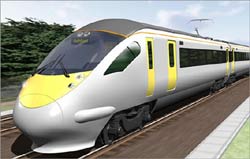US stimulus package provides $8 billion for rail expansion
18 Feb 2009
US President Barack Obama has announced a huge new federal investment of about $8 billion for high-speed passenger trains in his $787.2-billion economic recovery package signed yesterday.
 It is the first time that the United States is coming up with such a huge relief package for the railways. The administration officials also noted that the president is planning to add $1 billion more for high-speed rail in each of the next five years when he announces his 2010 budget next week.
It is the first time that the United States is coming up with such a huge relief package for the railways. The administration officials also noted that the president is planning to add $1 billion more for high-speed rail in each of the next five years when he announces his 2010 budget next week.
Obama signed the bill in Denver after the Congress approved the $787-billion package last week. The plan got no Republican support in the House of Representatives and just three Republican votes in the Senate.
Speaking at a signing ceremony he said it was "the most sweeping recovery package in our history".
The plan is aimed at saving or creating 35 lakh jobs and boosting consumer spending and rebuilding infrastructure.
Even during the campaign days Obama stressed on the need to boost high-speed railways as part of his vision of rebuilding America. While campaigning in Indiana, he talked about revitalising the Midwest by connecting cities with faster rail service to relieve congestion and improve energy conservation.
"The time is right now for us to start thinking about high-speed rail as an alternative to air transportation connecting all these cities," Obama said. "And think about what a great project that would be in terms of rebuilding America."
High-speed rail sailed through with surprisingly little attention paid to the president's role.
Those who were criticising Obama for some of his other programmes were more accomodative of the rail funds, since the Northeast corridor has a major stake in more improvements. To help pay for the cost of the railways, a business tax break, which provides a five-year carry back for net operating losses, was narrowed to keep the focus more on smaller firms with receipts of less than $15 million.
However, Republicans, such as Candice Miller, attacked the stimulus package saying that the whole funding is a scheme by senate majority leader Harry Reid on behalf of Las Vegas interests seeking a rail link to Los Angeles. One described the project as 'Sin City to Tomorrow Land'.
Experts consider connecting the high-speed corridors as a landmark decision. This will have regional effects in almost every corner of the nation, some opined.
In October 2008, former President George W Bush signed a bill authorising up to $1.5 billion for high-speed rail through 2013. However, Obama's commitment in the same period will be eight times that.
The administration has given 60 days to transportation secretary Ray LaHood to chalk out a plan to utilise the funds. The combination of large capital upfront - followed by annual appropriations - fits the prototype for the infrastructure bank once considered for, but never included in, the recovery bill.
"High-speed rail is the infrastructure bank," said White House chief of staff Rahm Emanuel, and the legislation gives Ray LaHood (transportation secretary) discretion to assign "priority to projects that support the development of intercity high-speed rail service."
The project is expected to get only lukewarm response from a section of leading freight carriers. But, capital investments in railways will benefit both freight operations and facilitate high-speed passenger service. With the drop in freight traffic, the railroads might be more cooperative, although they are sure to want some liability protection for accidents, one analyst said.
Emanuel said part of the plan would put Americans back to work in critical areas such as roads and rail infrastructure.






















